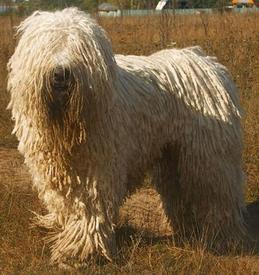
Originally thought to have been brought into existence by nomadic Magyars, the true origin of the Komondor is likely to belong with the Cumans; the word Komondor translates to 'dog of the Cumans,' and Komondor remains have been uncovered in Cuman grave sites, perhaps indication enough as to the early founders of the breed. Referenced in written records dating back to the 16th century, the Komondor is an old breed of Hungarian flock guardian, utilised in protecting livestock from predators and thieves. Descending from Tibetan dogs, the Komondor is a highly distinctive breed, bearing a resemblance to the Caucasian Orcharka, a possible forebear of the breed. The Komondor was nearly made extinct following the Cold War and Second World War when imports from Hungary were ended, only being resurrected by the efforts of careful breeding when links were finally regained in 1962. Recognised by the AKC in 1937.
Boasting a solid and muscular body, the Komondor is well adapted to life as a livestock guard and protector. With a large head, a relatively short muzzle, elongated ears and a long tail hanging to the hocks, the Komondor is not easily mistaken for any other breed. Perhaps the most characteristic feature of the Komondor is its profuse corded coat, commonly coloured white and cream. Not only would the coat have served to insulate the breed from extreme temperatures while guarding through the night, it would have offered camouflage amongst the sheep, helping to prevent injury if a predator was to attack. It can take up to 5 years before the cords reach their full length.
A highly intelligent breed with good trainability; the Komondor originated as a heavy, working breed and maintains an instinctual working temperament today. With a weight ranging up to 59 kg depending on gender and a life expectancy of 10-12 years, the Komondor is a resilient and vigilant breed, alert to threat and change. With an easy, sedate temperament, this is the ideal breed choice for families, whilst being a great companion for a sole owner. Very active-minded, the Komondor benefits from wide outdoor spaces where it can exercise and play. Due to the large size and strength of the Komondor, early training is imperative.
Re-bred for its inherent hardiness, the Komondor is not susceptible to any genetic or breed-specific health complaints, but like most dogs, may potentially be afflicted by hip dysplasia and optical disorders. Bloat and gastric tortion have been identified in the breed due to its large size, two potentially fatal conditions if left untreated for any length of time. Otherwise, this breed is generally healthy and long-lived, when shown appropriate care.
Do you own a Komondor? Let others know what they're like!
Related products
Advantage 80 Spot On Flea Control Large Cats and Rabbits
from £12.95
Advantage 40 Spot On Flea Control Cats, Small Dogs and Rabbits
from £12.95
Advantage 100 Spot On Flea Control Medium Dog
from £12.95
Advantage 250 Spot On Flea Control Large Dog
from £12.95
Drontal Tasty Bone Wormer Tablets for Small & Medium Dogs (2 to 20kg)
from £2.15
TermaWorm™ Tablets for Cats & Dogs
from £1.59
FRONTLINE Plus Flea & Tick Treatment Dogs & Cats
from £17.49
Drontal Tasty Bone XL Wormer Tablets for Large Dogs (Over 20kg)
from £6.39